Related Research Articles

Citrus production encompasses the production of citrus fruit, which are the highest-value fruit crop in terms of international trade. There are two main markets for citrus fruit:

Citrus greening disease is a disease of citrus caused by a vector-transmitted pathogen. The causative agents are motile bacteria, Liberibacter spp. The disease is transmitted by the Asian citrus psyllid, Diaphorina citri, and the African citrus psyllid, Trioza erytreae, also known as the two-spotted citrus psyllid. It has no known cure. It has also been shown to be graft-transmissible. Three different types of HLB are currently known: the heat-tolerant Asian form, and the heat-sensitive African and American forms. The disease was first described in 1929 and first reported in China in 1943. The African variation was first reported in 1947 in South Africa, where it is still widespread. Eventually, it affected the United States, reaching Florida in 2005. Within three years, it had spread to the majority of citrus farms. The rapid increase in this disease has threatened the citrus industry not only in Florida, but the entire US. As of 2009, 33 countries have reported HLB infection in their citrus crop.
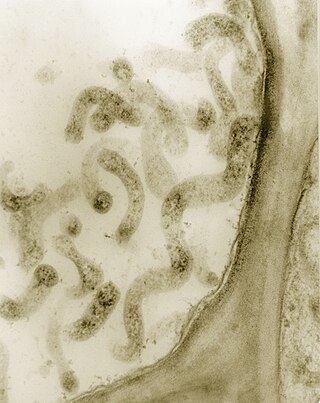
Spiroplasma is a genus of Mollicutes, a group of small bacteria without cell walls. Spiroplasma shares the simple metabolism, parasitic lifestyle, fried-egg colony morphology and small genome of other Mollicutes, but has a distinctive helical morphology, unlike Mycoplasma. It has a spiral shape and moves in a corkscrew motion. Many Spiroplasma are found either in the gut or haemolymph of insects where they can act to manipulate host reproduction, or defend the host as endosymbionts. Spiroplasma are also disease-causing agents in the phloem of plants. Spiroplasmas are fastidious organisms, which require a rich culture medium. Typically they grow well at 30 °C, but not at 37 °C. A few species, notably Spiroplasma mirum, grow well at 37 °C, and cause cataracts and neurological damage in suckling mice. The best studied species of spiroplasmas are Spiroplasma poulsonii, a reproductive manipulator and defensive insect symbiont, Spiroplasma citri, the causative agent of citrus stubborn disease, and Spiroplasma kunkelii, the causative agent of corn stunt disease.

Citrus canker is a disease affecting Citrus species caused by the bacterium Xanthomonas. Infection causes lesions on the leaves, stems, and fruit of citrus trees, including lime, oranges, and grapefruit. While not harmful to humans, canker significantly affects the vitality of citrus trees, causing leaves and fruit to drop prematurely; a fruit infected with canker is safe to eat, but too unsightly to be sold. Citrus canker is mainly a leaf-spotting and rind-blemishing disease, but when conditions are highly favorable, it can cause defoliation, shoot dieback, and fruit drop.

Xylella fastidiosa is an aerobic, Gram-negative bacterium of the genus Xylella. It is a plant pathogen, that grows in the water transport tissues of plants' and is transmitted exclusively by xylem sap-feeding insects such as sharpshooters and spittlebugs. Many plant diseases are due to infections of X. fastidiosa, including bacterial leaf scorch, oleander leaf scorch, coffee leaf scorch (CLS), alfalfa dwarf, phony peach disease, and the economically important Pierce's disease of grapes (PD), olive quick decline syndrome (OQDS), and citrus variegated chlorosis (CVC). While the largest outbreaks of X. fastidiosa–related diseases have occurred in the Americas and Europe, this pathogen has also been found in Taiwan, Israel, and a few other countries worldwide.

Aster yellows is a chronic, systemic plant disease caused by several bacteria called phytoplasma. The aster yellows phytoplasma (AYP) affects 300 species in 38 families of broad-leaf herbaceous plants, primarily in the aster family, as well as important cereal crops such as wheat and barley. Symptoms are variable and can include phyllody, virescence, chlorosis, stunting, and sterility of flowers. The aster leafhopper vector, Macrosteles quadrilineatus, moves the aster yellows phytoplasma from plant to plant. Its economic burden is primarily felt in the carrot crop industry, as well as the nursery industry. No cure is known for plants infected with aster yellows. Infected plants should be removed immediately to limit the continued spread of the phytoplasma to other susceptible plants. However, in agricultural settings such as carrot fields, some application of chemical insecticides has proven to minimize the rate of infection by killing the vector.

Curly top is a viral disease that affects many crops. This disease causes plants to become smaller in size, have shriveled petals and leaves, and are twisted and pulled out of shape. They are often caused by curtoviruses, members of the virus family Geminiviridae. This disease is important in western United States, such as California, Utah, Washington, and Idaho.
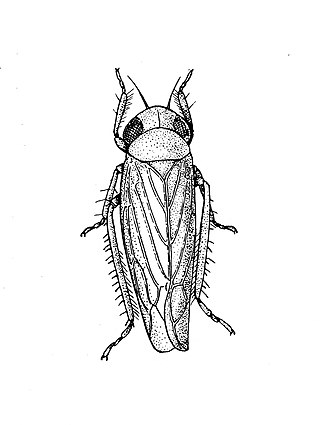
The beet leafhopper, also sometimes known as Neoaliturus tenellus, is a species of leafhopper which belongs to the family Cicadellidae in the order Hemiptera.
Alternaria citri is a fungal plant pathogen that causes black rot in citrus plants.
Elsinoë mangiferae, common name "mango scab", is also known Denticularia mangiferae or Sphaceloma mangiferae (anamorph). It is an ascomycete plant pathogen native to tropical regions and specific for survival on only one host, the mango. Originally described in 1943 from Florida and Cuba specimens, this pathogen has since spread worldwide and is becoming a pathogen of great concern for the mango industries in Australia and India. The species was first described formally in 1946.

Beet curly top virus (BCTV) is a pathogenic plant virus of the family Geminiviridae, containing a single-stranded DNA. The family Geminiviridae consists of nine genera based on their host range, virus genome structure, and type of insect vector. BCTV is a Curtovirus affecting hundreds of plants. The only known vector is the beet leafhopper, which is native to the Western United States.
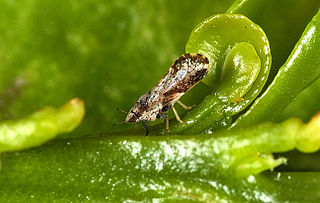
Diaphorina citri, the Asian citrus psyllid, is a sap-sucking, hemipteran bug in the family Psyllidae. It is one of two confirmed vectors of citrus greening disease. It has a wide distribution in southern Asia and has spread to other citrus growing regions.
Citrus exocortis is a disease of citrus plants, caused by the Citrus exocortis viroid (CEVd). It can cause stunted growth and reduced yields in affected plants. The disease is also sometimes called "scalybutt". CEVd can also infect tomato plants. The resulting disease is sometimes called "tomato bunchy top disease."
Spiroplasma citri is a bacterium species and the causative agent of Citrus stubborn disease.
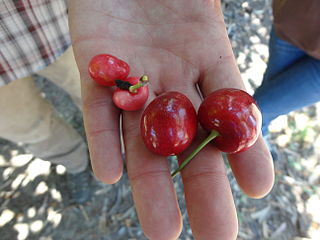
Cherry X disease also known as Cherry Buckskin disease is caused by a plant pathogenic phytoplasma. Phytoplasmas are obligate parasites of plants and insects. They are specialized bacteria, characterized by their lack of a cell wall, often transmitted through insects, and are responsible for large losses in crops, fruit trees, and ornamentals. The phytoplasma causing Cherry X disease has a fairly limited host range mostly of stone fruit trees. Hosts of the pathogen include sweet cherry, sour cherry, choke cherry, peaches, nectarines, almonds, clover, and dandelion. Most commonly the pathogen is introduced into economical fruit orchards from wild choke cherry and herbaceous weed hosts. The pathogen is vectored by mountain and cherry leafhoppers. The mountain leafhopper vectors the pathogen from wild hosts to cherry orchards but does not feed on the other hosts. The cherry leafhopper feeds on cherry trees and can transmit the disease from cherry orchards to peach, nectarine, and other economic crops. Control of Cherry X disease is limited to controlling the spread, vectors, and weed hosts of the pathogen. Once the pathogen has infected a tree it is fatal and removal is necessary to stop it from becoming a reservoir for vectors.
Papaya Bunchy Top Disease was first discovered in 1931 in Puerto Rico. Early on, the identity of the pathogen was highly contested due to the inability of isolating it; thus Koch’s postulates could not be fulfilled. Scientists have previously believed that Papaya Bunchy Top Disease was caused by a virus, a mycoplasma-like organism (MLO), or a phytoplasma, but these possible pathogens have since been disproven. Since the identity of the pathogen was unknown, all diagnoses were given solely based on a list of commonly associated symptoms. Through sequencing and microscopy, scientists identified the pathogen to be a part of the genus Rickettsia in 1996. The bacterium is described as being rod-shaped, small, gram-negative, and laticifer-inhibiting. Rickettsia causes diseases in animals, such as typhus and spotted fever, as well as in other plants, such as phony disease of peach and almond leaf scorch. Papaya Bunchy Top is found throughout the American tropics and has been economically important due to its major impact on fruit production. There is little information about the current economic impact.
Pecan bacterial leaf scorch is a disease of the pecan tree that is common throughout the production regions of the United States caused by the pathogenic bacterium Xylella fastidiosa subsp. multiplex. The pathogen was initially discovered to be coincidentally associated with symptoms of pecan fungal leaf scorch in 1998 and has subsequently been found to be endemic in the southeastern United States, as well as Arizona, California, and New Mexico.
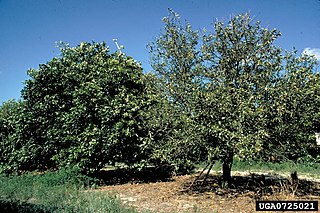
Citrus blight is a type of blight that occurs in tropical and semi-tropical regions. Specializing in infecting citrus trees, the blight is found in North America, the Caribbean, South America, South Africa and Australia. The blight injures plants by forming blockages in xylem and phloem, inhibiting resource distribution and resulting in plant die-back and smaller fruit yields. As of 2020 there is no cure for the blight, and neither the causal agent nor spreading mechanism is known.
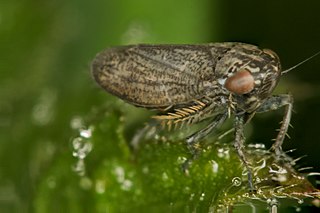
Euscelis incisa is a leafhopper species in the family Cicadellidae. It is found in Europe, North Africa, and Asia. It is formerly known as Euscelis plebejus, among other names.
References
- ↑ Polymerase Chain Reaction-Based Detection of Spiroplasma citri Associated with Citrus Stubborn Disease. Raymond K. Yokomi, Alexandre F. S. Mello, Maria Saponari and Jacqueline Fletcher, Plant Disease, February 2008, Volume 92, Number 2, pages 253-260, doi : 10.1094/PDIS-92-2-0253
- 1 2 3 Weller, Stephen C.; Ashton, Floyd M.; Ashton, Floyd M. (2002). Weed Science : Principles and Practices (4 ed.). New York: John Wiley & Sons. pp. xi+671. ISBN 0-471-27496-8. OCLC 51169076.
- ↑ Leafhoppers transmit citrus stubborn disease to weed host. George H. Kaloostian, George N. Oldfield, Edmond C. Calavan and Richard L. Blue, California Agriculture, September 1976, Volume 30, Number 9, pages 4-5, doi : 10.3733/ca.v030n09p4
- ↑ Occurrence of Spiroplasma citri in periwinkle in California. A.L. Granett, R.L. Blue, M.K. Harjung, E.C. Calavan, D.J. Gumpf, California Agriculture, volume 30, issue 3, pages 18-19, doi : 10.3733/ca.v030n03p18
- ↑ New hosts of citrus stubborn disease. Oldfield G.N., Kaloostian G.H., Pierce H.D., Sullivan D.A., Calavan E.C. and Blue R.L., Citrograph, 1977, Volume 62, Number 10, pages 309-312 (abstract [ permanent dead link ])
- ↑ Spiroplasmas are the causal agents of citrus little-leaf disease. P. G. Markham, R. Townsend, M. Bar-Joseph, M. J. Daniels, A. Plaskitt and B. M. Meddins, Annals of Applied Biology, September 1974, Volume 78, Issue 1, pages 49–57, doi : 10.1111/j.1744-7348.1974.tb01484.x
- 1 2 3 4 "UC IPM: UC Management Guidelines for Stubborn Disease on Citrus". ipm.ucanr.edu. Retrieved 2016-12-07.
- 1 2 3 4 5 6 7 "Stubborn Disease of Citrus in California". ANR Blogs. Retrieved 2016-12-07.
- 1 2 "Publication : USDA ARS". www.ars.usda.gov. Retrieved 2016-12-07.
- 1 2 "Fact Sheet: Citrus stubborn disease (CSD) | Citrus Diseases". idtools.org. Retrieved 2016-12-07.
- 1 2 3 4 5 6 7 Mello, Alexandre (May 2010). "New Perspectives on the Epidemiology of Citrus Stubborn Disease in California Orchards" (PDF). Plant Management Network.
- 1 2 3 4 Mello, Alexandre. "EFFECT OF CITRUS STUBBORN DISEASE ON NAVEL ORANGE PRODUCTION IN A COMMERCIAL ORCHARD IN CALIFORNIA" (PDF). Italian Phytopathological Society.
- "Citrus Diseases." Fact Sheet: Citrus Stubborn Disease (CSD) | Citrus Diseases. N.p., n.d. Web. 07 Dec. 2016.